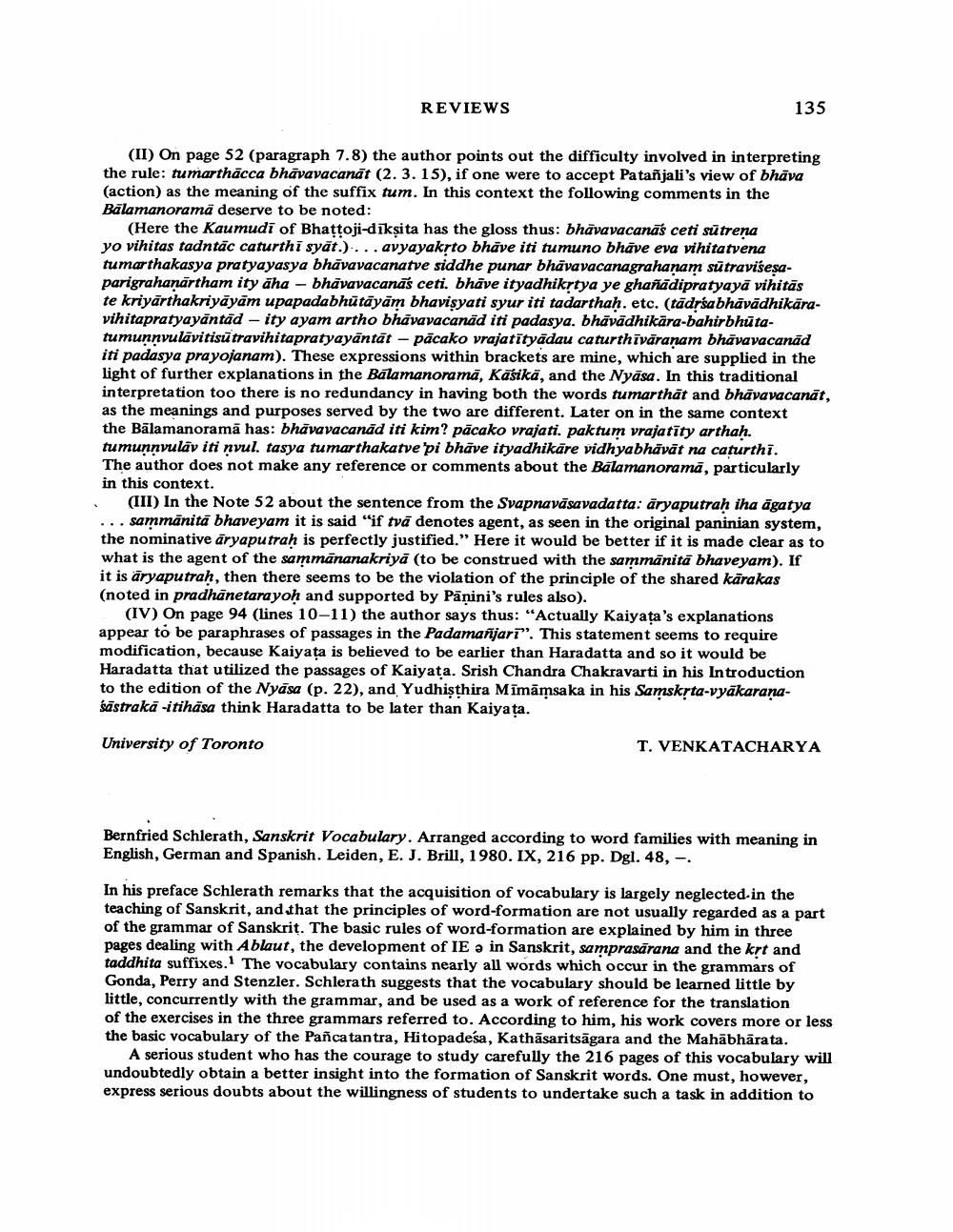________________
REVIEWS
135
(II) On page 52 (paragraph 7.8) the author points out the difficulty involved in interpreting the rule: tumarthācca bhävavacanät (2. 3. 15), if one were to accept Patanjali's view of bhāva (action) as the meaning of the suffix tum. In this context the following comments in the Balamanorama deserve to be noted:
(Here the Kaumudi of Bhattoji-diksita has the gloss thus: bhävavacanas ceti sütrena yo vihitas tadntāc caturthi syāt.).... avyayakyto bhāve iti tumuno bhäve eva vihitatvena tumarthakasya pratyayasya bhāvavacanatve siddhe punar bhävavacanagrahanam sūtraviśesaparigrahanartham ity aha - bhāvavacanās ceti. bhāve ityadhikrtya ye ghañadipratyayā vihitās te kriyārthakriyāyām upapadabhūtāyām bhavisyati syur iti tadarthah. etc. (tādrśabhāvādhikaravihitapratyayantad - ity ayam artho bhāvavacanād iti padasya. bhävādhikära-bahirbhūtatumunnvulāvitisū travihitapratyayāntāt - pācako vrajatītyādau caturthivaranam bhāvavacanād iti padasya prayojanam). These expressions within brackets are mine, which are supplied in the light of further explanations in the Balamanorama, Kašikā, and the Nyasa. In this traditional interpretation too there is no redundancy in having both the words tumarthāt and bhāvavacanāt, as the meanings and purposes served by the two are different. Later on in the same context the Bālamanorama has: bhāvavacanād iti kim? pācako vrajati. paktum vrajatīty arthah. tumunnvulāv iti nvul. tasya tumarthakatve pi bhāve ityadhikare vidhyabhāvāt na caturthi. The author does not make any reference or comments about the Balamanorama, particularly in this context.
(III) In the Note 52 about the sentence from the Svapnavāsavadatta: äryaputrah iha agatya ... sammanita bhaveyam it is said "if två denotes agent, as seen in the original paninian system, the nominative aryaputrah is perfectly justified." Here it would be better if it is made clear as to what is the agent of the sammānanakriyā (to be construed with the sammänitā bhaveyam). If it is äryaputrah, then there seems to be the violation of the principle of the shared kärakas (noted in pradhanetara yoh and supported by Pāņini's rules also).
(IV) On page 94 (lines 10-11) the author says thus: “Actually Kaiyata's explanations appear to be paraphrases of passages in the Padamañjari". This statement seems to require modification, because Kaiyața is believed to be earlier than Haradatta and so it would be Haradatta that utilized the passages of Kaiyata. Srish Chandra Chakravarti in his Introduction to the edition of the Nyasa (p. 22), and Yudhisthira Mimāņsaka in his Samskrta-vyakaranaśästraka -itihäsa think Haradatta to be later than Kaiyata.
University of Toronto
T. VENKATACHARYA
Bernfried Schlerath, Sanskrit Vocabulary. Arranged according to word families with meaning in English, German and Spanish. Leiden, E. J. Brill, 1980. IX, 216 pp. Dgl. 48,
In his preface Schlerath remarks that the acquisition of vocabulary is largely neglected in the teaching of Sanskrit, and that the principles of word-formation are not usually regarded as a part of the grammar of Sanskrit. The basic rules of word-formation are explained by him in three pages dealing with Ablaut, the development of IE a in Sanskrit, samprasarana and the krt and taddhita suffixes. The vocabulary contains nearly all words which occur in the grammars of Gonda, Perry and Stenzler. Schlerath suggests that the vocabulary should be learned little by little, concurrently with the grammar, and be used as a work of reference for the translation of the exercises in the three grammars referred to. According to him, his work covers more or less the basic vocabulary of the Pañcatantra, Hitopadesa, Kathāsaritsägara and the Mahābhārata.
A serious student who has the courage to study carefully the 216 pages of this vocabulary will undoubtedly obtain a better insight into the formation of Sanskrit words. One must, however, express serious doubts about the willingness of students to undertake such a task in addition to




